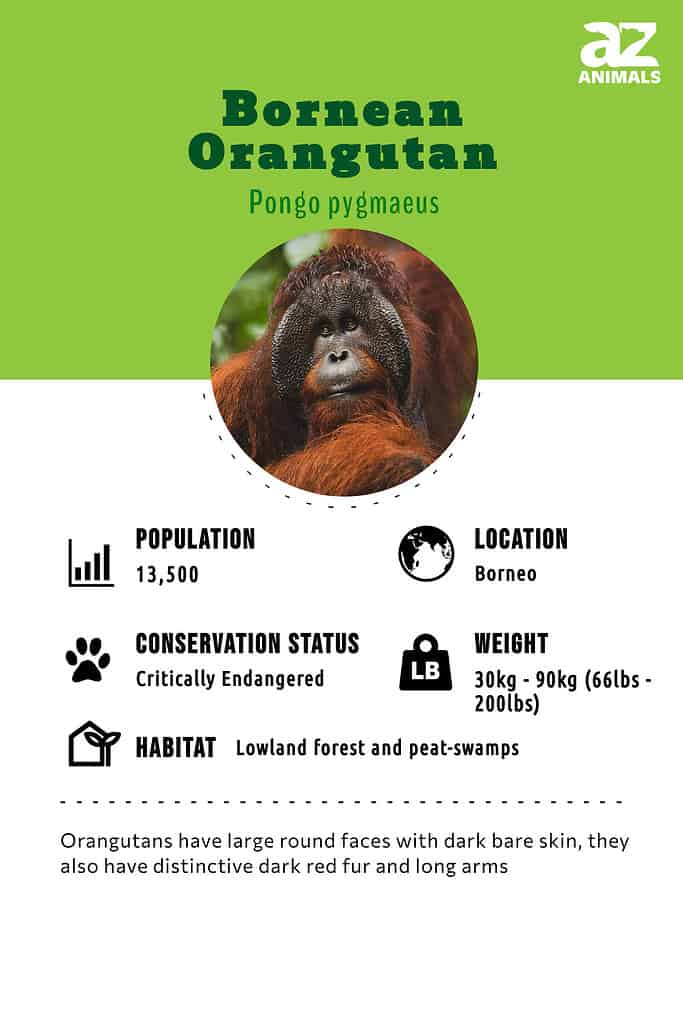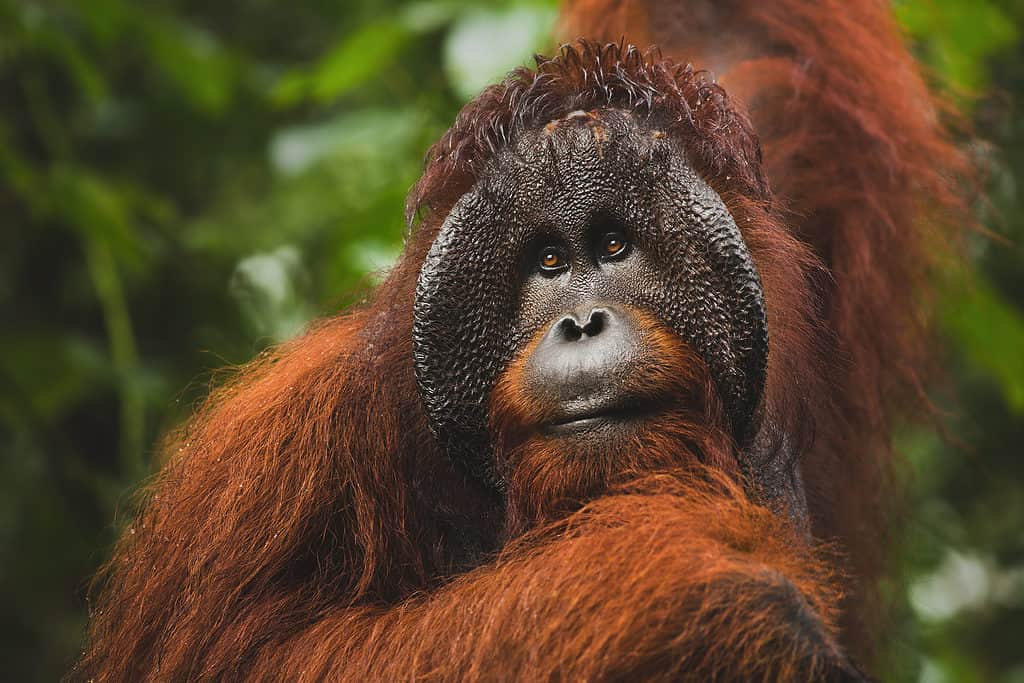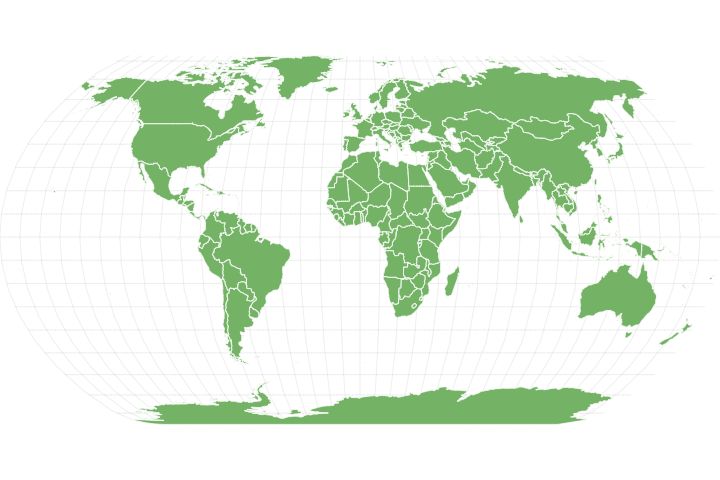Bornean Orangutan
Pongo pygmaeus
Known to use large leaves as umbrellas!
Advertisement
Bornean Orangutan Scientific Classification
- Kingdom
- Animalia
- Phylum
- Chordata
- Class
- Mammalia
- Order
- Primates
- Family
- Hominidae
- Genus
- Pongo
- Scientific Name
- Pongo pygmaeus
Read our Complete Guide to Classification of Animals.
Bornean Orangutan Conservation Status
Bornean Orangutan Facts
- Prey
- Fruits, Bark, Insects
- Name Of Young
- Infant
- Group Behavior
- Solitary
- Fun Fact
- Known to use large leaves as umbrellas!
- Estimated Population Size
- 13,500
- Biggest Threat
- Habitat loss
- Most Distinctive Feature
- Highly intelligent with very long arms
- Other Name(s)
- Red Ape, Forest People
- Gestation Period
- 9 months
- Habitat
- Lowland forest and peat-swamps
- Diet for this Fish
- Omnivore
- Average Litter Size
- 1
- Lifestyle
- Diurnal
- Common Name
- Bornean orangutan
- Number Of Species
- 3
- Location
- Borneo
- Slogan
- Known to use large leaves as umbrellas!
- Group
- Mammal
Bornean Orangutan Physical Characteristics
- Color
- Brown
- Grey
- Red
- Black
- Orange
- Skin Type
- Hair
- Top Speed
- 2.7 mph
- Lifespan
- 30 - 40 years
- Weight
- 30kg - 90kg (66lbs - 200lbs)
- Height
- 1.25m - 1.5m (4ft - 5ft)
- Age of Sexual Maturity
- 12 - 15 years
- Age of Weaning
- 3 years
View all of the Bornean Orangutan images!

Classification and Evolution

The Bornean Orangutan is one of three species including the Sumatran and the Tapanuli
©Marketa Myskova/Shutterstock.com
The Bornean orangutan is a large primate species that is found inhabiting the humid tropical jungles of Borneo. Also known as the Red Ape, the Bornean orangutan is the second largest ape species in the world (after the gorilla) and is the largest tree-dwelling animal on the planet. Although the Bornean orangutan is closely related to the great apes found in Africa, they differ greatly in their behavior with the biggest difference being that the Bornean orangutan is largely solitary where other ape species tend to adopt complex social hierarchies. Until recently there was thought to only be one orangutan species but recent genetic research has shown that there are in fact three species of orangutan which are the Bornean orangutan, the Sumatran orangutan, and the Tapanuli orangutan, which are slightly smaller in size and tend to be more sociable than their larger cousin. There are considered to be three different sub-species of the Bornean orangutan, which although they are similar in appearance, are differentiated by the areas of the island that they occupy. They are the Northwest Bornean orangutan, the Central Bornean orangutan and the Northeast Bornean orangutan.
Anatomy and Appearance
The Bornean orangutan is covered in patchy red or orange hair with its coarse grey skin being visible in some places. As they are largely arboreal mammals, the Bornean orangutan has a number of adaptations that help it when in the canopy including having feet that can grip as effectively as its hands, and arms that can grow to a span of more than two meters and are actually 30% longer than their legs. The face of the Bornean orangutan is bare and displays the grey or black color of its skin. Mature males also develop fleshy cheek pouches which are made up of fat deposits under the skin, along with throat poaches that are able to produce a deep, resonating sound through the forest. Both male and female Bornean orangutans are specially designed for opening and eating fruits with dexterous hands and feet for peeling and large flat teeth that help to grind down harder seeds and tree bark.
Distribution and Habitat
The Bornean orangutan is natively found on the island of Borneo where it inhabits areas of dense primary forest, mainly in the lowlands and valleys. Although they can be found at elevations of up to 1,500 meters they tend to prefer the lush slopes further down due to the higher abundance and variety of food. Although the Bornean orangutan (and indeed the Sumatran orangutan) were once widespread throughout south-east Asia, they are today confined to the two islands which they named after but are seriously vulnerable in their natural surroundings due to logging and forest fires which have decimated much of their once vast native regions. Due to the fact that the Bornean orangutan spends nearly all of its life high in the tree canopy, they rely on these dense and rich jungles to survive, and with less and less of their natural habitats remaining, they are being forced into smaller and more isolated regions away from the increasing levels of human activity.
Behavior and Lifestyle
Unlike the other great ape species, the Bornean orangutan is largely solitary with the exception of mother and infant pairs and the gathering of a number of individuals around heavily laden fruit trees. Bornean orangutans spend much of their days sitting and eating in the canopy before constructing a nest by folding leafy branches over, where they sleep at night. Bornean orangutans move slowly through the steamy forests and as they are too heavy to jump, they rely on swinging tree branches back and forth until they can get close enough to grab onto the next one. Despite only traveling just over half a mile a day, Bornean orangutans can occupy vast home ranges that are loosely shared with other individuals with males having breeding rights with any female that enters their patch, marking their presence with deep, loud calls which echo through the trees.
Reproduction and Life Cycle
The Bornean orangutan is known to breed year-round but these slow-developing and maturing animals are not able to reproduce until they are often nearly 15 years old. After a gestation period that lasts for up to nine months, the female Bornean orangutan gives birth to a single infant which clings to its mother’s fur and is completely dependent on her for up to 10 years. Despite the young Bornean orangutans being weaned when they are around three years old, offspring continue to shadow their mother so as to learn about what to eat and where to find it and also for safety. Eventually leaving her to establish their own territory when they are at least eight years old, young females tend to remain close to their mother whereas young males can roam the forest for a long time before they finally find a patch of their own. Bornean orangutans tend to live for up to 35 years in the wild but can reach almost double that age in captivity.
Diet and Prey
The Bornean orangutan is technically an omnivorous animal which means that they find and eat a variety of both plant and animal matter. Despite this, Bornean orangutans love fruit with around 60% of their diet being comprised of a wide variety of both ripe and unripe fruits including mangoes, durian, figs, and lychees. In the tropics though, different trees bare their fruits at different times of the year so Bornean orangutans must make a mental note of where the fruit trees are and when their fruits ripen. In order to supplement their diet though, Bornean orangutans also eat a range of plant matter including young shoots and leaves along with insects, eggs, and small vertebrates such as lizards on occasion. Although in areas where there is a rich and abundant supply of food Bornean orangutans are known to congregate together to feed, one of the reasons why they are so solitary is that if they lived together in a group in one area, there simply would not be enough food to go around.
Predators and Threats
Historically Bornean orangutans would hardly ever come down to the ground in fear of being preyed upon by large carnivores like tigers, bears, and clouded leopards but with the extinction of the tiger particularly throughout much of the island males are known to spend around 5% of their time on the forest floor. However, 40,000 years ago a new threat emerged in the form of modern humans that hunted the Bornean orangutan to extinction in numerous parts of their once vast natural range. Today they are protected by law but infants are still captured for the exotic pet trade and the mothers are often killed in the process. The biggest threat though to Borneo’s remaining orangutan populations is habitat loss in the form of deforestation for logging or to clear land for farming and agriculture, primarily to make way for palm oil plantations.
Interesting Facts and Features
The sound that male Bornean orangutans make to mark their territories comes from their developing throat pouch and is so booming that it can travel for more than a mile throughout the forest, to not only attract females but also to intimidate rival males. Bornean orangutans are unique amongst great apes as their arboreal lifestyle has led to their limbs having more mobility than other species, allowing them to negotiate around tricky branches more easily. In the same way however to other great ape species, Bornean orangutans have been observed using tools to help them in their daily lives. Seemingly dependent on where the individual lives, skills are passed onto infants from their mothers with sticks being used to extract termites and honey and even large leaves are used as a form of umbrella to keep the Bornean orangutan dry.
Relationship with Humans
Since their arrival in south-east Asia modern humans have been fascinated by this slow-moving and majestic mammal with their name in the native Malay language meaning “man of the forest” or “forest people”. Bornean orangutans are remarkably similar to us both in their appearance and behavior with these highly intelligent creatures having evolved perfectly to their tropical, tree-dwelling lives. However, the hunting of the Bornean orangutan and the deforestation of its once vast natural habitat has led to drastic declines in their population numbers particularly over the past century. Adults are often killed if they are seen in or close to plantations when looking for food and their young are captured to be sold into the exotic pet trade, despite their heavy legal protection.
Conservation Status and Life Today
Today, the Bornean orangutan is listed by the IUCN as a species that is Critically Endangered in its natural environment and is therefore severely threatened by extinction in the near future. The loss of their historic, unique, and incredibly bio-diverse habitats has led to a 92% drop in their population numbers in the past 100 years and if things continue the way they are going, it will not be long before they have disappeared from the wild forever. Rehabilitation programs exist throughout the island and so far seem to be having relative success but with deforestation (now even in protected areas) for logging and clearing land to make way for palm oil plantations, population numbers can only be expected to continue to fall.
View all 285 animals that start with BBornean Orangutan FAQs (Frequently Asked Questions)
Are Bornean Orang-utans herbivores, carnivores, or omnivores?
Bornean Orang-utans are Omnivores, meaning they eat both plants and other animals.
What Kingdom do Bornean Orang-utans belong to?
Bornean Orang-utans belong to the Kingdom Animalia.
What class do Bornean Orang-utans belong to?
Bornean Orang-utans belong to the phylum Chordata.
What phylum to Bornean Orang-utans belong to?
Bornean Orang-utans belong to the phylum Chordata.
What family do Bornean Orang-utans belong to?
Bornean Orang-utans belong to the family Hominidae.
What order do Bornean Orang-utans belong to?
Bornean Orang-utans belong to the order Primates.
What type of covering do Bornean Orang-utans have?
Bornean Orang-utans are covered in Hair.
What genus do Bornean Orang-utans belong to?
Bornean Orang-utans belong to the genus Pongo.
Where do Bornean Orang-utans live?
Bornean Orang-utans live in Borneo.
In what type of habitat do Bornean Orang-utans live?
Bornean Orang-utans live in lowland forests and peat swamps.
What are some predators of Bornean Orang-utans?
Predators of Bornean Orang-utans include humans, tigers, and clouded leopards.
How many babies do Bornean Orang-utans have?
The average number of babies a Bornean Orang-utan has is 1.
What is an interesting fact about Bornean Orang-utans?
Bornean Orang-utans are known to use large leaves as umbrellas!
What is the scientific name for the Bornean Orang-utan?
The scientific name for the Bornean Orang-utan is Pongo pygmaeus.
What is the lifespan of a Bornean Orang-utan?
Bornean Orang-utans can live for 30 to 40 years.
How many species of Bornean Orang-utan are there?
There are 3 species of Bornean Orang-utan.
What is the biggest threat to the Bornean Orang-utan?
The biggest threat to the Bornean Orang-utan is habitat loss.
What is another name for the Bornean Orang-utan?
The Bornean Orang-utan is also called the red ape or forest person.
How many Bornean Orang-utans are left in the world?
There are 13,500 Bornean Orang-utans left in the world.
How fast is a Bornean Orang-utan?
A Bornean Orang-utan can travel at speeds of up to 2.7 miles per hour.
How to say Bornean Orangutan in ...
Thank you for reading! Have some feedback for us? Contact the AZ Animals editorial team.
Sources
- David Burnie, Dorling Kindersley (2011) Animal, The Definitive Visual Guide To The World's Wildlife
- Tom Jackson, Lorenz Books (2007) The World Encyclopedia Of Animals
- David Burnie, Kingfisher (2011) The Kingfisher Animal Encyclopedia
- Richard Mackay, University of California Press (2009) The Atlas Of Endangered Species
- David Burnie, Dorling Kindersley (2008) Illustrated Encyclopedia Of Animals
- Dorling Kindersley (2006) Dorling Kindersley Encyclopedia Of Animals
- David W. Macdonald, Oxford University Press (2010) The Encyclopedia Of Mammals
- Bornean Orang-utan Facts, Available here: http://www.enchantedlearning.com/subjects/apes/orangutan/
- Bornean Orang-utan Information, Available here: http://animals.nationalgeographic.com/animals/mammals/orangutan/
- Bornean Orang-utan Conservation, Available here: http://www.iucnredlist.org/apps/redlist/details/17975/0

















